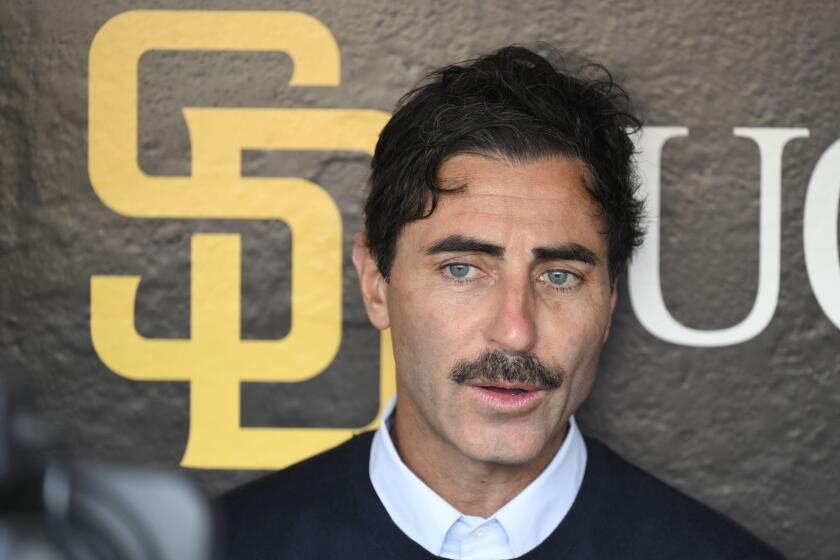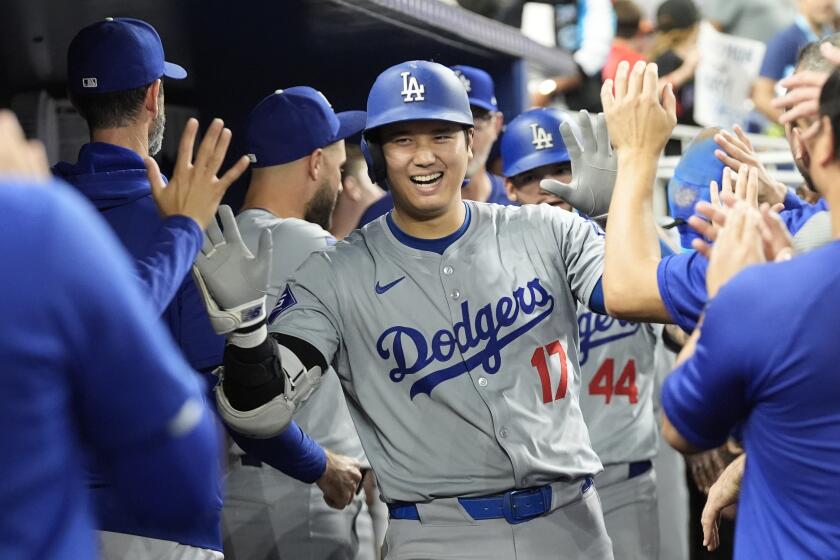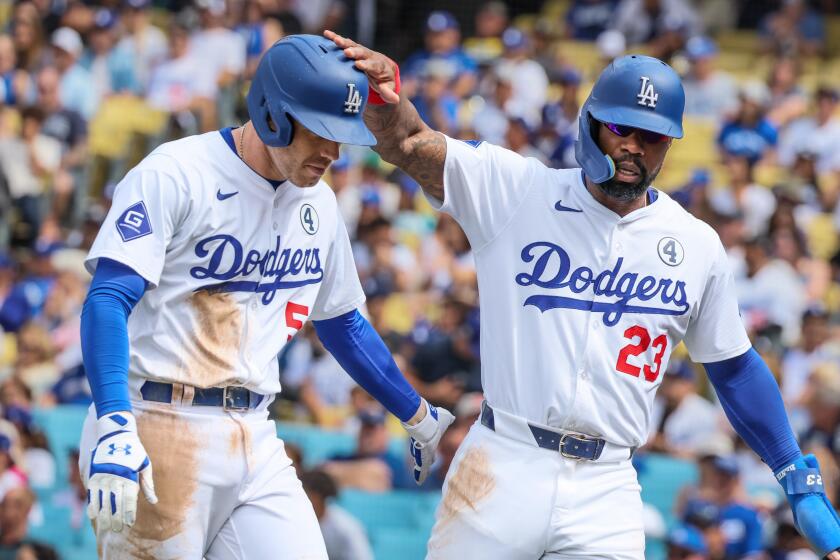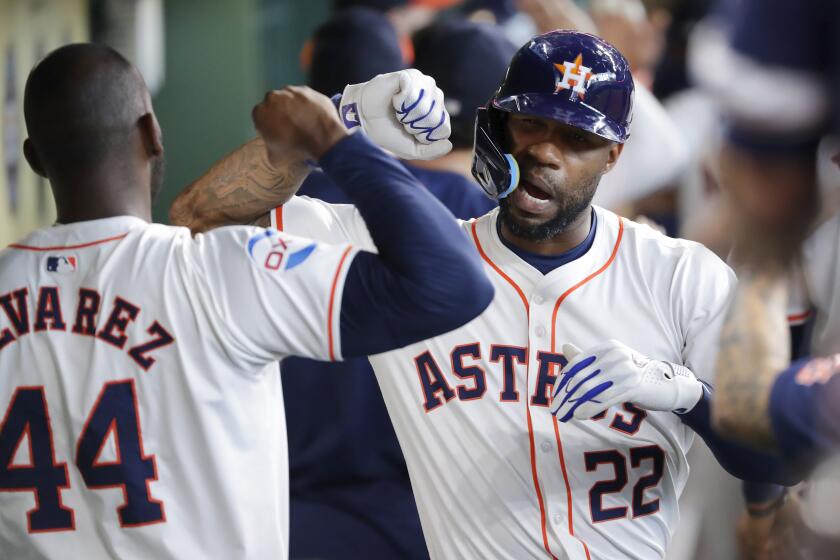After another blown save, Dodgers closer Kenley Jansen still searching for answers
Hidden behind a partition in the visitors clubhouse at Petco Park, Dodgers closer Kenley Jansen was scrolling through his iPhone when a reporter approached on Wednesday afternoon. Jansen looked up and wondered what the visitor wanted to talk about. The topic felt obvious.
On a recent four-game winning streak, the Dodgers (8-9) regained some equilibrium. Clayton Kershaw sparked the stretch with 12 strikeouts in a victory over Arizona. The offense scored 37 runs in four games, including 30 in a three-game sweep of San Diego. Yet the alarm bells triggered by Jansen’s performance to start the season had not yet faded into the background.
After blowing his second save of the season on Tuesday against the Padres, Jansen insisted on maintaining a positive attitude. He vowed to fix the deficiencies in his delivery that have dampened the velocity and the movement of his cut fastball. And he welcomed the criticism he earned by posting an 8.10 earned-run average in his first seven appearances.
“I have one of the hardest jobs in the game,” Jansen said. “I’m either going to save it, or I’m going to talk to you guys more frequently. That’s the one thing I tell myself: I’m not going to let anything bother me.”
The Dodgers recovered on Tuesday to win in extra innings. But manager Dave Roberts still sounded weary a day after the game. He admitted that he had not pinpointed an explanation for Jansen’s trouble in the season’s opening month. He lamented a series of pitches that were “as straight as a string,” but could not diagnose why Jansen’s cutter had stopped cutting.
Theories for Jansen’s struggles run amok. He might still be dealing with a hamstring issue from the spring. He might not have built up enough arm strength during the spring. At 30, he might be weary after pitching into the playoffs for five years in a row. In the eyes of some scouts, he may no longer frighten opposing hitters, who know Jansen will attack them with elevated cutters and little else.
Or, as Jansen assessed it, this might be a simple issue with his delivery magnified because closers walk a nightly tightrope.
Roberts maintained faith in Jansen. He indicated that there were no discussions about shifting him into a different role. Roberts did not see how a lower-leverage assignment might aid Jansen: If his pitches aren’t cooperating, he could blow a lead in the seventh inning as easily as he could in the ninth.
“With his track record, guys like that, you’ve got to let them work through it,” Roberts said. “It is a little more difficult when you’re talking to the closer. But regardless of where the roles are at, for anyone in relief, those innings matter. Whether it’s the sixth, seventh, eighth or ninth, they’re really important innings.”
Jansen huddled with pitching coach Rick Honeycutt and bullpen coach Mark Prior before Wednesday’s game. Earlier this month, after Jansen’s first blown save, Honeycutt suggested Jansen was compensating for a bout of hamstring stiffness he experienced during spring training. Unsure of his ability to stride with his delivery, Jansen could not produce the necessary velocity, with the pitch hovering around 89-90 mph.
Jansen saw his velocity increase as time passed. But he believed he identified another flaw. His front foot is not landing in a consistent location, which causes his command to falter. He experienced the downside of that limitation on Tuesday, when Padres first baseman Eric Hosmer homered on a lifeless 90-mph fastball that barely moved.
“Once the landing spot is inconsistent, that arm slot is going to be inconsistent,” Jansen said. “That very first pitch to Eric Hosmer, he didn’t have a shot. I saw it too. I’m like, ‘Oh, shoot, I found a home.’ And then the next pitch, I threw like a misfired cutter down the middle. It deserved to get hit.”
On Wednesday afternoon, Jansen ventured onto the field hours before the Dodgers took batting practice. He usually warms up while his teammates hit, but he wanted an atmosphere that was “quiet and peaceful,” devoid of distractions, he said. As he played catch, he focused on the defects in his delivery, aiming to rebuild the muscle memory he lost over the winter.
“From what I’ve seen so far, he takes a lot of pride in what he does,” Prior said. “He’s out there every day trying to get better. He’s trying to find that right magic that he’s had over the last however many years he’s been doing this at such a high level. I believe in him.”
Jansen earned this faith. From 2015 to 2017, he led all relievers in FanGraph’s version of wins above replacement. After signing a five-year, $80-million contract before last season, Jansen responded with the finest campaign of his career, as he converted 41 of 42 save opportunities, posted a 1.32 ERA and finished with a 15.57-to-1 strikeout-to-walk ratio.
The history of dominance makes his recent vulnerability all the more striking. Jansen insisted that a revival would come soon.
“Yeah, the hitters don’t see it right now,” Jansen said. “But I’m going to make sure that they’re going to hate it when my name gets called. That’s the confidence I have. Once I get over this, they’re going to be like, ‘Oh shoot, he’s coming in.’ I’ve got to carry that confidence. I’m not going to let anything bother me.”
Twitter: @McCulloughTimes
More to Read
Are you a true-blue fan?
Get our Dodgers Dugout newsletter for insights, news and much more.
You may occasionally receive promotional content from the Los Angeles Times.











